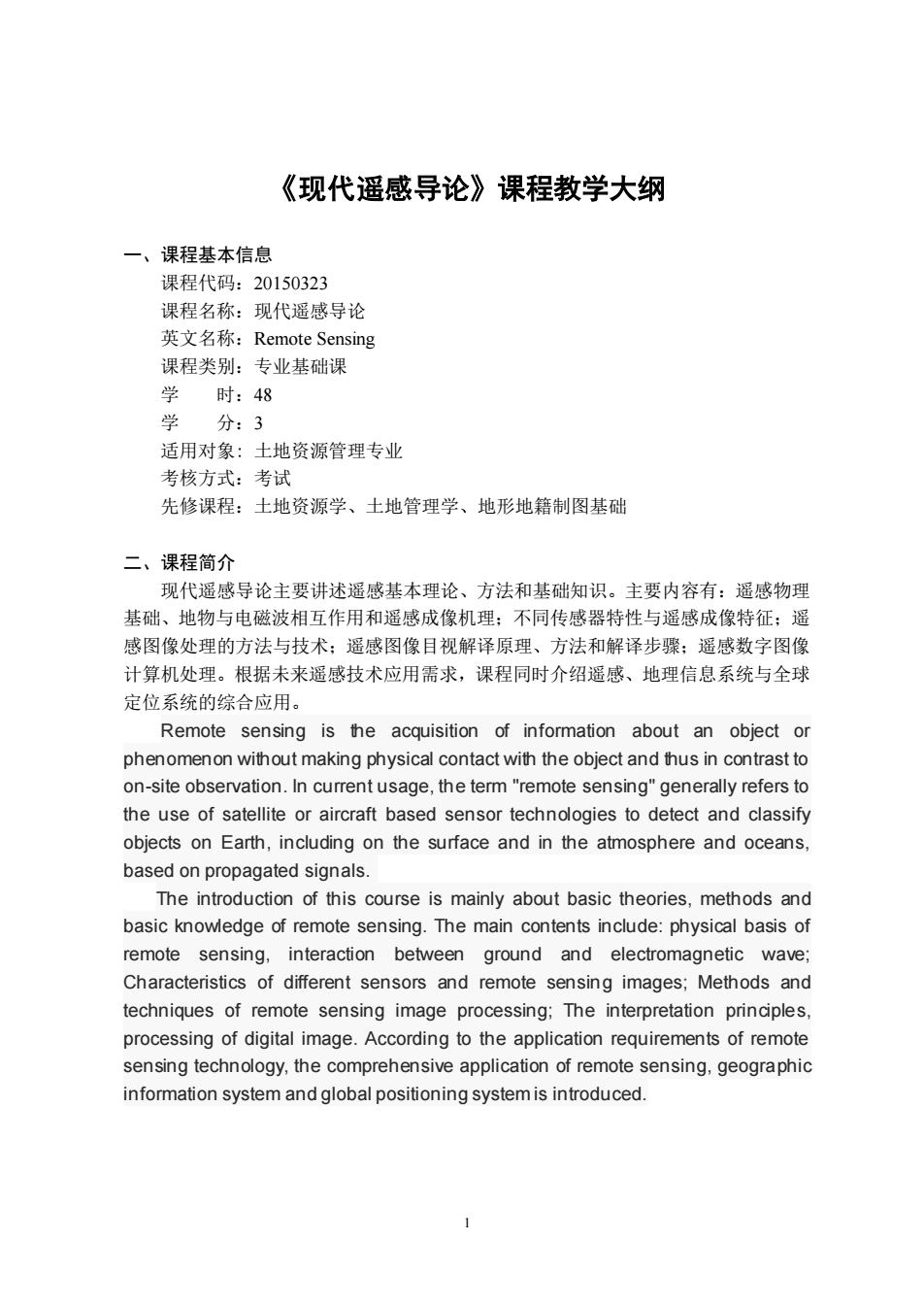正在加载图片...

《现代遥感导论》课程教学大纲 一、课程基本信息 课程代码:20150323 课程名称:现代遥感导论 英文名称:Remote Sensing 课程类别:专业基础课 时:48 学 分:3 适用对象:土地资源管理专业 考核方式:考试 先修课程:土地资源学、土地管理学、地形地籍制图基础 二、课程简介 现代遥感导论主要讲述遥感基本理论、方法和基础知识。主要内容有:遥感物理 基础、地物与电磁波相互作用和遥感成像机理;不同传感器特性与遥感成像特征:遥 感图像处理的方法与技术:遥感图像目视解译原理、方法和解译步骤:遥感数字图像 计算机处理。根据未来遥感技术应用需求,课程同时介绍遥感、地理信息系统与全球 定位系统的综合应用。 Remote sensing is the acquisition of information about an object or phenomenon without making physical contact with the object and thus in contrast to on-site observation.In current usage,the term "remote sensing"generally refers to the use of satellite or aircraft based sensor technologies to detect and classify objects on Earth,including on the surface and in the atmosphere and oceans, based on propagated signals The introduction of this course is mainly about basic theories,methods and basic knowledge of remote sensing.The main contents include:physical basis of remote sensing,interaction between ground and electromagnetic wave; Characteristics of different sensors and remote sensing images;Methods and techniques of remote sensing image processing:The interpretation principles, processing of digital image.According to the application requirements of remote sensing technology,the comprehensive application of remote sensing,geographic information system and global positioning system is introduced.1 《现代遥感导论》课程教学大纲 一、课程基本信息 课程代码:20150323 课程名称:现代遥感导论 英文名称:Remote Sensing 课程类别:专业基础课 学 时:48 学 分:3 适用对象: 土地资源管理专业 考核方式:考试 先修课程:土地资源学、土地管理学、地形地籍制图基础 二、课程简介 现代遥感导论主要讲述遥感基本理论、方法和基础知识。主要内容有:遥感物理 基础、地物与电磁波相互作用和遥感成像机理;不同传感器特性与遥感成像特征;遥 感图像处理的方法与技术;遥感图像目视解译原理、方法和解译步骤;遥感数字图像 计算机处理。根据未来遥感技术应用需求,课程同时介绍遥感、地理信息系统与全球 定位系统的综合应用。 Remote sensing is the acquisition of information about an object or phenomenon without making physical contact with the object and thus in contrast to on-site observation. In current usage, the term "remote sensing" generally refers to the use of satellite or aircraft based sensor technologies to detect and classify objects on Earth, including on the surface and in the atmosphere and oceans, based on propagated signals. The introduction of this course is mainly about basic theories, methods and basic knowledge of remote sensing. The main contents include: physical basis of remote sensing, interaction between ground and electromagnetic wave; Characteristics of different sensors and remote sensing images; Methods and techniques of remote sensing image processing; The interpretation principles, processing of digital image. According to the application requirements of remote sensing technology, the comprehensive application of remote sensing, geographic information system and global positioning system is introduced